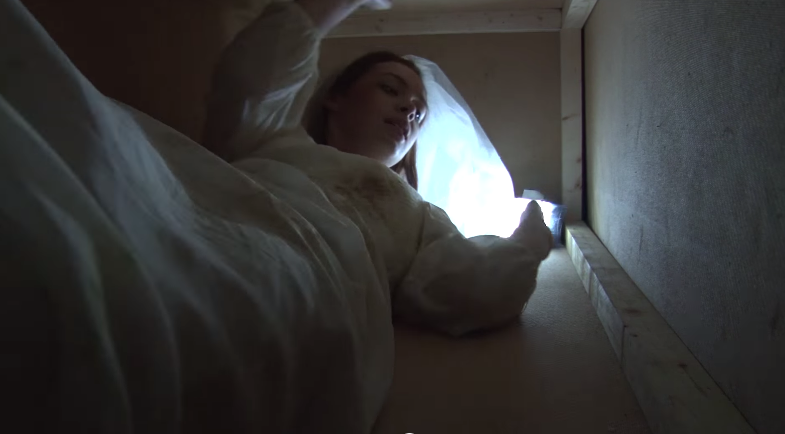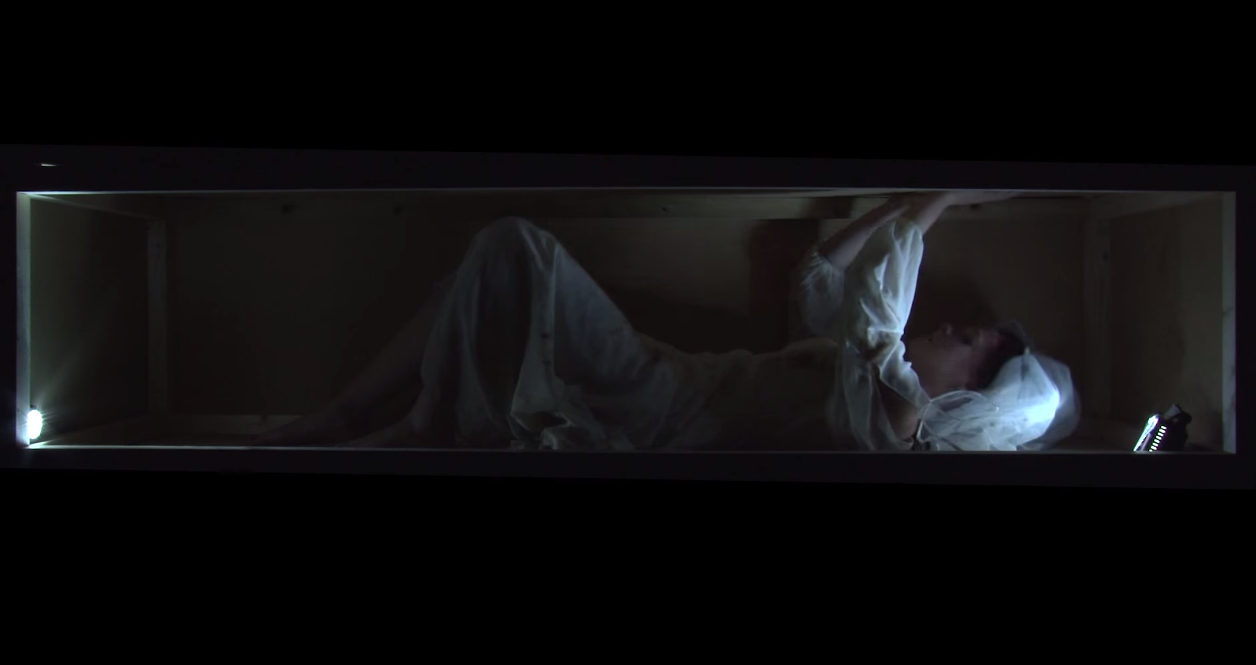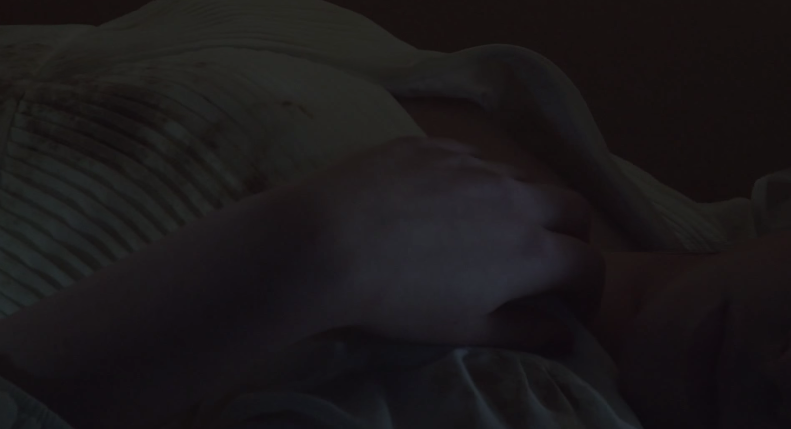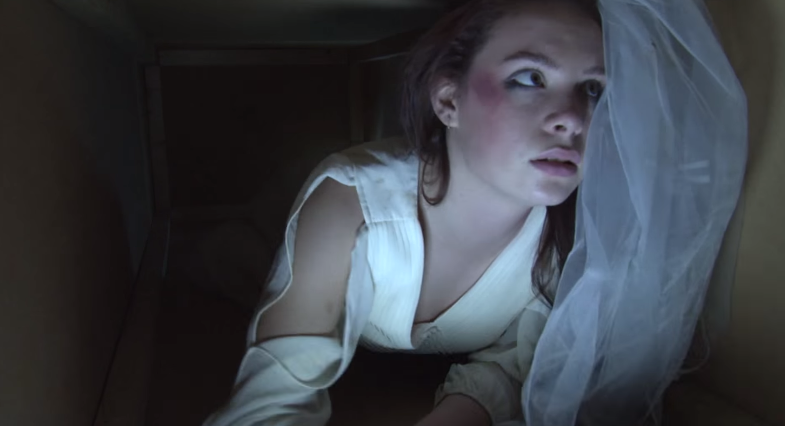The mise-en-scene used in our opening
thriller sequence are used represent our female main character.
 Her character
positioning, of her below the ground and being able to hear a male above her
suggests that she is subservient to a male character, which in a way is
adhering to the stereotype of women.
Her character
positioning, of her below the ground and being able to hear a male above her
suggests that she is subservient to a male character, which in a way is
adhering to the stereotype of women.
There are no other characters in the sequence, which suggests to an audience that she is isolated and helpless, which also is adhering to the stereotype of women, that they cannot help themselves; they need to have help from a male.
There are no props used within the coffin, but the coffin itself that she is contained in, showing her helplessness.
She is in a white wedding dress; this could suggest that she is pure and again not strong enough to fight for her life. However, the
contrast between her age and the wedding dress gives sympathy to the audience for the character as she has been put in this position. The fact that she is wearing makeup and has made an effort with her appearing makes the audience think that she is not going to be strong as she is probably vein and possibly selfish and would adhere to the stereotype of woman who make an effort with their appearance rely on others to help them.
 Her facial expression and speech pretty
much tells the narrative as the space is so restricted and there is no
interaction with any other characters apart from the man who is burying her.
She wakes up naïve to what has happened and then begins to panic, this is
adhering to the stereotype of woman panicking and thinking initially about how
to save herself logically. Her facial expression changes when she hears a voice
from outside the coffin, saying it’s going to help her out, her eyes become
hopeful and relieved, adhering to the stereotype of females being naïve. Her facial
expression shows that she is shocked that he is piling dirt on top of her
coffin, that she had that trust with someone she didn’t know, just because they
were the only one there to save her, she thought he was going to which is again
naïve to think that in this unlikely situation, the coincidence that someone
would be able to find and help her is slim. She then reverts back to panicking.
Her facial expression switches from her screaming to just panic in her eyes but
she still lays there silent, but you can see by her expression that she knows
she is going to have to not panic to be able to get out of the coffin alive,
this is stereotypically thinking like a man so subverting to her stereotype,
logically and rationally and not just screaming to try and get attention to get
someone else to help her out of her situation. The lighting in the box is
minimal, which I think again enhances the image of her being helpless and
isolated but it also helps to enhance her facial expressions in some of the
shots to show her emotional state. The repetition of the mise-en-scene elements
suggesting she is isolated, makes the audience think about if she is going to
adhere to the stereotype of females not coping well in isolation and she will
just suffer, or if she will adhere to the stereotype of females not being able
to figure their way out of situations by themselves and needing help constantly
from males.
Her facial expression and speech pretty
much tells the narrative as the space is so restricted and there is no
interaction with any other characters apart from the man who is burying her.
She wakes up naïve to what has happened and then begins to panic, this is
adhering to the stereotype of woman panicking and thinking initially about how
to save herself logically. Her facial expression changes when she hears a voice
from outside the coffin, saying it’s going to help her out, her eyes become
hopeful and relieved, adhering to the stereotype of females being naïve. Her facial
expression shows that she is shocked that he is piling dirt on top of her
coffin, that she had that trust with someone she didn’t know, just because they
were the only one there to save her, she thought he was going to which is again
naïve to think that in this unlikely situation, the coincidence that someone
would be able to find and help her is slim. She then reverts back to panicking.
Her facial expression switches from her screaming to just panic in her eyes but
she still lays there silent, but you can see by her expression that she knows
she is going to have to not panic to be able to get out of the coffin alive,
this is stereotypically thinking like a man so subverting to her stereotype,
logically and rationally and not just screaming to try and get attention to get
someone else to help her out of her situation. The lighting in the box is
minimal, which I think again enhances the image of her being helpless and
isolated but it also helps to enhance her facial expressions in some of the
shots to show her emotional state. The repetition of the mise-en-scene elements
suggesting she is isolated, makes the audience think about if she is going to
adhere to the stereotype of females not coping well in isolation and she will
just suffer, or if she will adhere to the stereotype of females not being able
to figure their way out of situations by themselves and needing help constantly
from males.
 Her character
positioning, of her below the ground and being able to hear a male above her
suggests that she is subservient to a male character, which in a way is
adhering to the stereotype of women.
Her character
positioning, of her below the ground and being able to hear a male above her
suggests that she is subservient to a male character, which in a way is
adhering to the stereotype of women. There are no other characters in the sequence, which suggests to an audience that she is isolated and helpless, which also is adhering to the stereotype of women, that they cannot help themselves; they need to have help from a male.
There are no props used within the coffin, but the coffin itself that she is contained in, showing her helplessness.
She is in a white wedding dress; this could suggest that she is pure and again not strong enough to fight for her life. However, the
contrast between her age and the wedding dress gives sympathy to the audience for the character as she has been put in this position. The fact that she is wearing makeup and has made an effort with her appearing makes the audience think that she is not going to be strong as she is probably vein and possibly selfish and would adhere to the stereotype of woman who make an effort with their appearance rely on others to help them.
 Her facial expression and speech pretty
much tells the narrative as the space is so restricted and there is no
interaction with any other characters apart from the man who is burying her.
She wakes up naïve to what has happened and then begins to panic, this is
adhering to the stereotype of woman panicking and thinking initially about how
to save herself logically. Her facial expression changes when she hears a voice
from outside the coffin, saying it’s going to help her out, her eyes become
hopeful and relieved, adhering to the stereotype of females being naïve. Her facial
expression shows that she is shocked that he is piling dirt on top of her
coffin, that she had that trust with someone she didn’t know, just because they
were the only one there to save her, she thought he was going to which is again
naïve to think that in this unlikely situation, the coincidence that someone
would be able to find and help her is slim. She then reverts back to panicking.
Her facial expression switches from her screaming to just panic in her eyes but
she still lays there silent, but you can see by her expression that she knows
she is going to have to not panic to be able to get out of the coffin alive,
this is stereotypically thinking like a man so subverting to her stereotype,
logically and rationally and not just screaming to try and get attention to get
someone else to help her out of her situation. The lighting in the box is
minimal, which I think again enhances the image of her being helpless and
isolated but it also helps to enhance her facial expressions in some of the
shots to show her emotional state. The repetition of the mise-en-scene elements
suggesting she is isolated, makes the audience think about if she is going to
adhere to the stereotype of females not coping well in isolation and she will
just suffer, or if she will adhere to the stereotype of females not being able
to figure their way out of situations by themselves and needing help constantly
from males.
Her facial expression and speech pretty
much tells the narrative as the space is so restricted and there is no
interaction with any other characters apart from the man who is burying her.
She wakes up naïve to what has happened and then begins to panic, this is
adhering to the stereotype of woman panicking and thinking initially about how
to save herself logically. Her facial expression changes when she hears a voice
from outside the coffin, saying it’s going to help her out, her eyes become
hopeful and relieved, adhering to the stereotype of females being naïve. Her facial
expression shows that she is shocked that he is piling dirt on top of her
coffin, that she had that trust with someone she didn’t know, just because they
were the only one there to save her, she thought he was going to which is again
naïve to think that in this unlikely situation, the coincidence that someone
would be able to find and help her is slim. She then reverts back to panicking.
Her facial expression switches from her screaming to just panic in her eyes but
she still lays there silent, but you can see by her expression that she knows
she is going to have to not panic to be able to get out of the coffin alive,
this is stereotypically thinking like a man so subverting to her stereotype,
logically and rationally and not just screaming to try and get attention to get
someone else to help her out of her situation. The lighting in the box is
minimal, which I think again enhances the image of her being helpless and
isolated but it also helps to enhance her facial expressions in some of the
shots to show her emotional state. The repetition of the mise-en-scene elements
suggesting she is isolated, makes the audience think about if she is going to
adhere to the stereotype of females not coping well in isolation and she will
just suffer, or if she will adhere to the stereotype of females not being able
to figure their way out of situations by themselves and needing help constantly
from males.
The editing we have used, help portray our
character in our thriller. The pace of the shots is very slow at the beginning
to show her thinking and her calm thought as she is unaware of what is going
on. As she begins to realize where she is and that she is the only one who can
help herself, the pace increases to reflect her mental state that she is
panicking to how she is going to get help. This is adhering to the stereotype
of women that they need help to survive. The pace towards the end decreases
which subverts her need for help as she is going to think logically about how
to help herself and save her life.

 The camera angles used help to portray the
emotional state of the female character in the sequence. The hand help shot of
the opening camera angle just introduces the character, but the fact that it is
hand help gives the impression that she is being watched and that she is a
subject to viewing of sort. The low angle shot shows that she is at an end of
the box with nowhere to go. As she begins to look around the box, the camera
angle is at a high angle to her which gives the audience a chance to see her
face as she is facing into the light, the fact that she tries to search around
the box where the light is could suggest that she is looking for an easy way
out, to search the area which is known, rather that to explore the darker
corners. The close up shots of her hands enhances the fact that she is calling
for help and rather that using her hands to help herself she is using them to
call for others to help her which is adhering to the stereotype of her asking
people to help her out of unfortunate situations. The long shot of the whole
coffin allows the audience to notice where she is positioned, isolated and
being able to realize with her that she is going to have to work by herself to
get out of there. When the shot goes to a close up and she reaches her ear up
to the top of the coffin, it highlights that
The camera angles used help to portray the
emotional state of the female character in the sequence. The hand help shot of
the opening camera angle just introduces the character, but the fact that it is
hand help gives the impression that she is being watched and that she is a
subject to viewing of sort. The low angle shot shows that she is at an end of
the box with nowhere to go. As she begins to look around the box, the camera
angle is at a high angle to her which gives the audience a chance to see her
face as she is facing into the light, the fact that she tries to search around
the box where the light is could suggest that she is looking for an easy way
out, to search the area which is known, rather that to explore the darker
corners. The close up shots of her hands enhances the fact that she is calling
for help and rather that using her hands to help herself she is using them to
call for others to help her which is adhering to the stereotype of her asking
people to help her out of unfortunate situations. The long shot of the whole
coffin allows the audience to notice where she is positioned, isolated and
being able to realize with her that she is going to have to work by herself to
get out of there. When the shot goes to a close up and she reaches her ear up
to the top of the coffin, it highlights thatshe is subservient to whoever has put her there, as she is below them.
The sound of the characters breath at the beginning
of the sequence shows that it is so silent in there, that she is all alone and
there isn’t even ambient sound, helps to establish her setting. The only sounds
in the coffin are coming from her, which exaggerates even her breaths, which is
a good indicator of her emotional state due to her increase in breath when she
comes to the realization of her fate. The sound of her screaming combined with
the loud banging on the top of the coffin shows her desperation for help in
contrast to the heavy breathing at the end when she feels defeated.
To conclude, I think that our thriller introduction sequence, we didn't empower the female character. We strongly adhered to the stereotypes and conventions of young female characters in the media. However towards the end of the plot for the rest of the film, we have decided to subvert the main female character to empower the female and to subvert the audiences prior beliefs.
To conclude, I think that our thriller introduction sequence, we didn't empower the female character. We strongly adhered to the stereotypes and conventions of young female characters in the media. However towards the end of the plot for the rest of the film, we have decided to subvert the main female character to empower the female and to subvert the audiences prior beliefs.



No comments:
Post a Comment